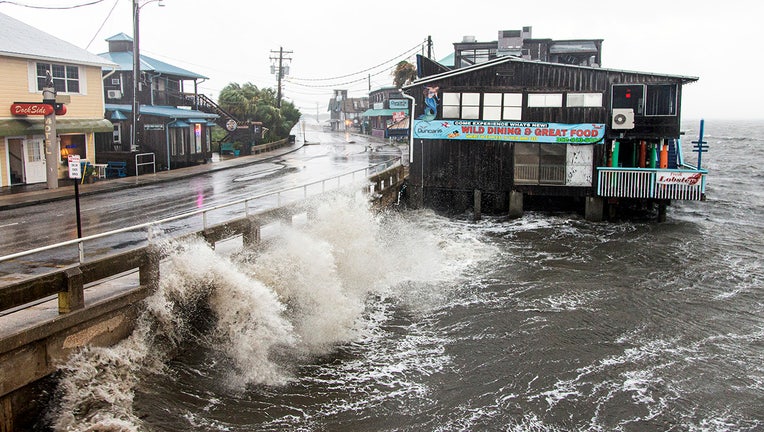Florida dodges bullet as storm season nears end

Tropical Storm Elsa makes landfall on July 7, 2021 in Cedar Key, Florida. (Photo by Mark Wallheiser/Getty Images)
TALLAHASSEE, Fla. - For the second consecutive year, the hurricane season has exhausted a list of storm names.
But with days to go before the Nov. 30 end of the season, Florida has had brushes with only three named systems – Elsa, Fred and Mindy – that were mostly rainmakers with tropical-storm force winds.
All things considered, the state has been relatively unscathed in the highly active storm season, allowing emergency staff in Florida – who also needed to react to wildfires and the COVID-19 pandemic – to continue addressing lingering impacts of past storms.
"We're still working Hurricane Michael. We're still working Hurricane Irma, Matthew, Hermine, Dorian and so on," said Kevin Guthrie, director of the state Division of Emergency Management. "So, yeah, it was good for us to be able to work on some of those past disasters and get them working towards closing out."
For a third year, Florida can chalk up the outcome of the six-month season to luck or the fate of wobbles.
"The storm season that happened last year in Louisiana, if you would have taken that track and moved it a number of miles to the east, then we would have had in that exact same path, you would have had major landfalling hurricanes into Jacksonville, the Panhandle and South Florida in the exact same year," Guthrie said.
Quoting National Hurricane Center Director Ken Graham, Guthrie added, "Wobbles matter. Little wobbles matter."
RELATED: 'Once in a lifetime' 1921 hurricane shows devastation Category 3 storm could have on Tampa Bay
This year was the sixth consecutive above-average storm season and came after Florida suffered historic strikes from Irma in 2017 and Michael in 2018. But this year is essentially the third consecutive season without a hurricane directly causing massive damage to Florida.
And there were opportunities, with much warmer than average sea-surface temperatures in the subtropical Atlantic, along with an enhanced west Africa monsoon and weak upper-level winds that contribute to easier hurricane formations.
"It only takes one big storm to cause problems in the state of Florida," Guthrie said. "This is not going to be the norm. We are Florida. We get hit by hurricanes. It is going to happen."

Cancelled flights are displayed on a screen at Tampa International Airport shortly before the airport closed as Tropical Storm Elsa moved northward toward the Tampa Bay area on July 6, 2021. (Photo by Paul Hennessy/Anadolu Agency via Getty Images)
The Atlantic saw 21 named storms, the third-most active season on record. That included seven hurricanes and four reaching Category 3 strength.
When Ana formed on May 22, forecasters recorded the seventh consecutive year in which a system emerged before the June 1 designated start of the season.
Elsa made landfall in Taylor County after dropping from hurricane to tropical-storm strength in early July. Tropical Storm Fred made landfall near Cape San Blas in the Panhandle with maximum sustained winds around 65 mph in mid-August. Tropical Storm Mindy found the Panhandle’s St. Vincent Island on Sept. 9.
With earlier and more active seasons seemingly becoming the norm, state lawmakers also might readjust efforts to help people prepare.
Sen. Joe Gruters, R-Sarasota, has proposed a measure (SB 808) that for the first time would split up what has been a sales tax "holiday" at the beginning of the storm season to help people stockpile disaster supplies.
Under Gruters’ proposal, which will be considered during the 2022 legislative session, tax breaks on supplies such as tarps, batteries, radios and portable generators would be offered from June 2 through June 6 and from Sept. 8 through Sept. 12.

